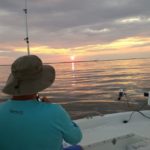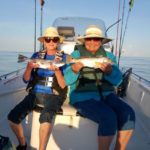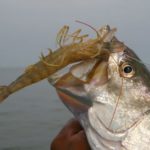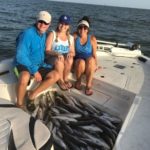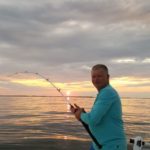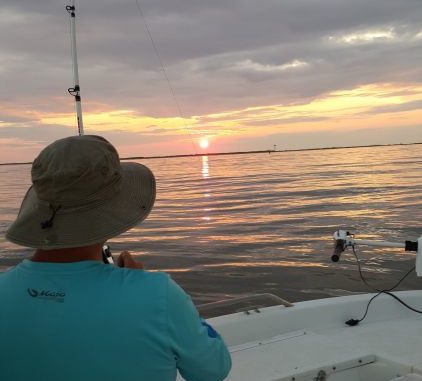
Late afternoon trout trips typically offer calmer winds, fewer boats, cooler temperatures — and plenty of specks. Here’s how one no-frills Fourchon angler avoids the crowd and still fills up his box.
Although he still gets up some mornings at 3 a.m. to participate in the rat race to go catch fish, Kevin Lawson admittedly isn’t as mad at speckled trout as he used to be.
Like many people who eventually mature to the point of not caring what anybody else really thinks, this Denham Springs angler makes no bones about grabbing some live shrimp, a box of treble hooks and some popping corks before launching his boat 12 hours later — at 3 in the afternoon.
Lawson kind of stumbled into the evening bite out of Port Fourchon a few summers ago when he started taking his mother Eathel Seal and some of her friends out on the water.
“Actually I didn’t stumble into it as much as she pushed me into it,” Lawson chuckled. “She told me she wasn’t getting up early to go fishing.
“You never hear about anybody going in the evening, and nobody will go with you in the evening, and they don’t take you in the evening — so you don’t know that the evening is even an option.”
But what Lawson found during the later trips was few to no boats, calm winds, calm water, slightly cooler temperatures — and lots of trout.
In fact, he started having some of the most memorable fishing trips of his life.
“Just last summer my mom came down with one of her friends, Pauline Bankston from Franklinton,” he said. “She had never even been saltwater fishing before, and she didn’t want to go in the morning, either.
“We had a couple other guys in the boat, and I mean to tell you it was everything we could do to keep those two ladies baited up and in the water — because they were hammering the trout one after another.”
The group boxed more than 80 specks, and that trip pretty much sealed the deal for Lawson committing himself more to targeting evenings for speckled trout.
A simple plan of attack
But he isn’t what you would call a technical angler. His approach to saltwater fishing out of Fourchon is more akin to his earliest white perch fishing trips in Washington Parish farm ponds.
“Man, I just fish around until I find some that want to bite,” he said. “I’d love to be able to tell you that because the wind was blowing from the west with a 1.2-foot tidal range that the trout were eating bait in a 4-foot trough off East Timbalier, but that’s not my approach.”
That’s why Lawson fell in love with fishing during the evening: It doesn’t require a technical approach, and literally anybody can go out there and do it and be successful.
“I guess if I had to come up with some kind of theory, I’d say that the trout aren’t as pressured during the evening so they’re more willing to bite,” he said. “And I think that might actually have something to do with it. I know deer and ducks respond better when they don’t have as much pressure on them, so it only stands to reason that fish would, too.”
Although Lawson’s approach tends to be more haphazard than technical, he does follow a plan as he works his way from Fourchon to East Timbalier.
“I start at the rocks coming out of Fourchon and hit the barges,” he said. “Then I hit a couple of the rigs on the way to East Timbalier. If time allows me to, I might work the same stuff in reverse on my way back in. It’s kind of a round-robin approach that works for me.”
Lawson fishes the same route during the mornings sometimes, and he has found that he definitely catches more trout during the evening than he does when the sun is rising.
The ‘Lawson rig’ gets it done
And he doesn’t do anything special to put trout in the boat.
“I fish live bait on a treble hook under a cork,” the self-deprecating angler said. “It’s so simple some of my friends call it the ‘Lawson rig’ — just like fishing one of Dickies Hy Way Pak minnows under a cork for white perch around Franklinton. It doesn’t take a lot of brains to do that.”
Lawson says his friends mess with him all the time and claim that he is cheating by fishing live bait under a cork, but he’s quick to respond that putting fish in the boat isn’t cheating — it’s called being successful.
His standard rig includes an H&H popping cork – the one with the black wire – and 3 feet of leader tied to a treble hook. The only deviation from this setup is adding 3 more feet to his leader when he’s fishing the rigs.
“As for the live shrimp,” Lawson continued, “I figure that if I’m going to spend $250 on gas, drinks and ice, another $50 on live shrimp is no big deal. If I’m driving that far to catch fish, I see live shrimp as insurance to keep me from going home with an empty box.”
And he believes a treble hook, which offers him two more chances to stick a fish per hook, are worth the hassle.
“They’re a little harder to deal with than a single hook,” he said, “but fish just don’t come off when they eat a live shrimp on a treble hook. I run one of the hooks under the horn up by the head. I don’t figure a fish even knows what it is when he eats it — shrimp have all those sharp points, anyway.
“But if you fish with treble hooks you better keep a good pair of pliers handy to help you take the hooks out, because they can get all kinds of tangled up in a fish.”
As far as his fishing technique goes, Lawson suggested that if he can catch fish like this in the evening then anybody could do the same.
“I’m not a very smart angler,” he laughed. “Seriously, I just troll around until I find a bunch of fish. Sure, if I see birds diving or shrimp jumping then I know to go there, but otherwise I just keep fishing. If they’re not biting here, I try over there. Sooner or later, I’ll come across a pile of them.”
At East Timbalier Lawson generally starts fishing about 75 yards off the island then trolls in and out as he works his way around – always with his live shrimp 3 feet under a cork.
When he’s on the rigs, Lawson has learned that the fish tend to be in a different spot just about every time, so the same ‘troll-around-until-he-finds-them’ approach works there, too.
Tidal movement is key
“About the only thing I insist on other than my live shrimp is some kind of tidal movement,” Lawson added. “I know some people that know exactly where to go based on what the tide is doing, but I’m just happy to have some moving water. That always makes things a lot easier, which is what fishing in the evening is all about.”
For a 3 to 7:30 p.m. trip, Lawson said 50 shrimp per person is about right, and he isn’t picky on sizes, taking whatever the bait shop dips out.
Having made a few morning trips out of the public ramp at Fourchon and then following them up with evening trips, Lawson says there is a marked difference in the number of trucks in the parking lot.
“You may see 50 to 60 trucks in the parking lot in the morning, but there might be only 10 in the evening, and some of those are there because they went to their camps,” he said. “I have fished out of there in the evening and literally seen no other boats on the water.”
Because of the simplicity of it all, the evening sets up nicely for introducing novice anglers to the sport. Whether kids, elderly parents or a friend who has never fished before, the evening offers a serene time to be on the water to learn without having to deal with crowds.
“I don’t have any statistics to back me up,” Lawson said, “but I would imagine there are more cases of boat rage in the morning than there would ever be in the evening.”
Benefits of being late
Although Lawson typically makes his summertime evening runs out of Fourchon, he says he has also had success fishing later at other hotspots around South Louisiana.
“As a matter of fact, I took my mom and a high school friend to Four Horse Lake out of Delacroix, and I’ve also had some good evening trips at the Trestles in Lake Pontchartrain,” Lawson added.
If you’re thinking Lawson’s simplified way to catching trout in the evening somehow makes him a simple-minded angler, he’s perfectly fine with that. He’s actually beyond caring what you think — and puts much more emphasis on what the trout think.
And based on what he’s seen on the water, trout must think he’s doing something right. In fact, Lawson might not be as mad at them as he used to be — but the trout are sure starting to get upset with him.
